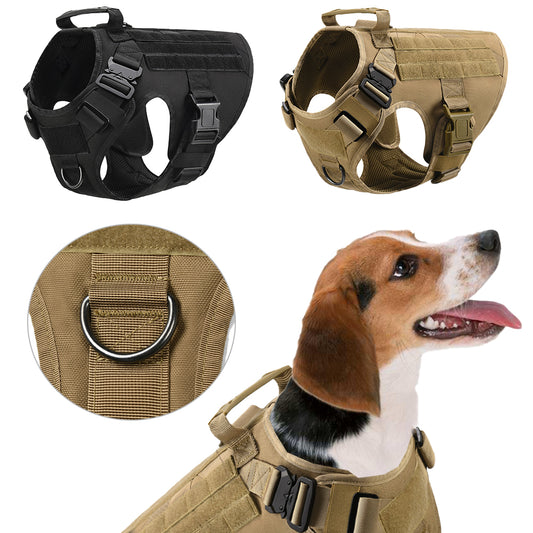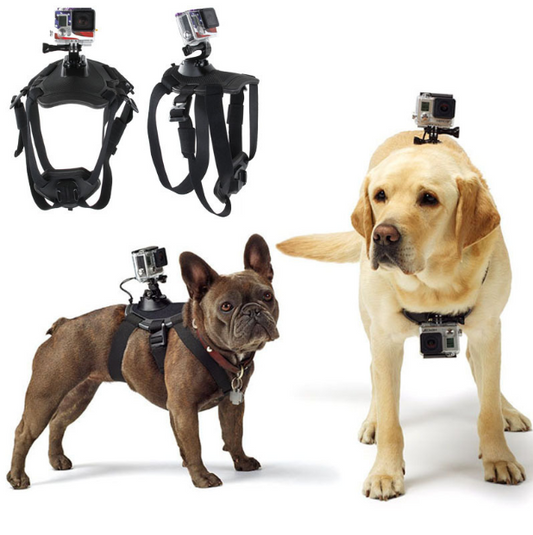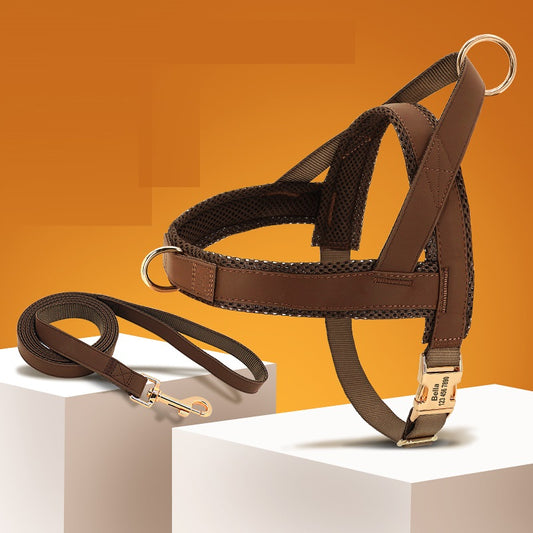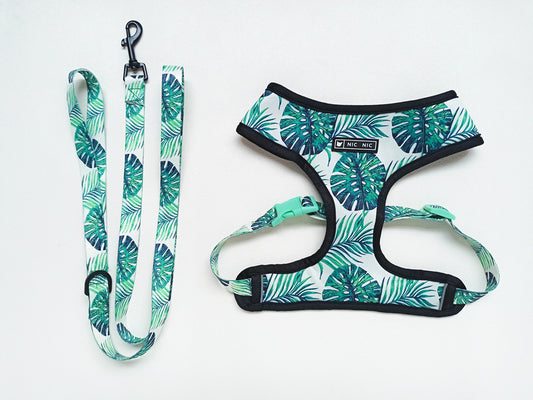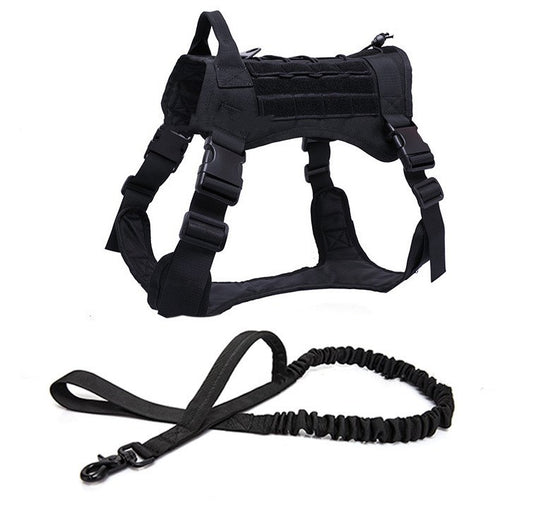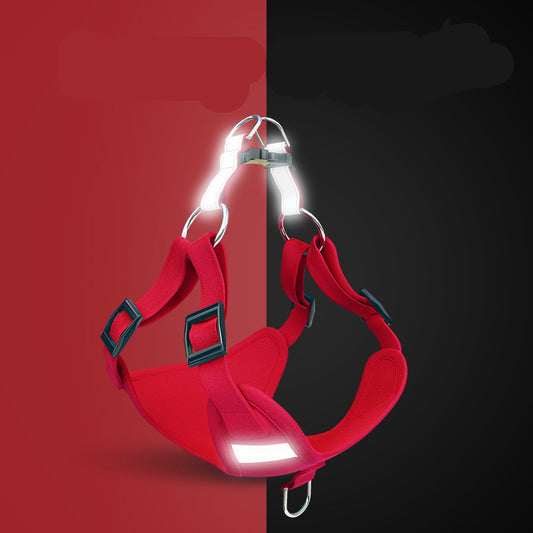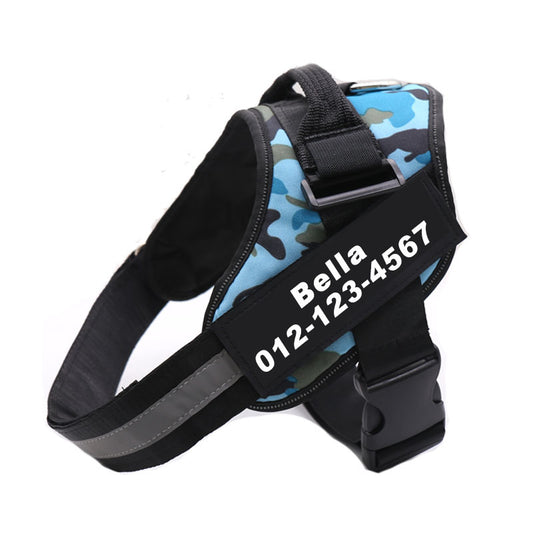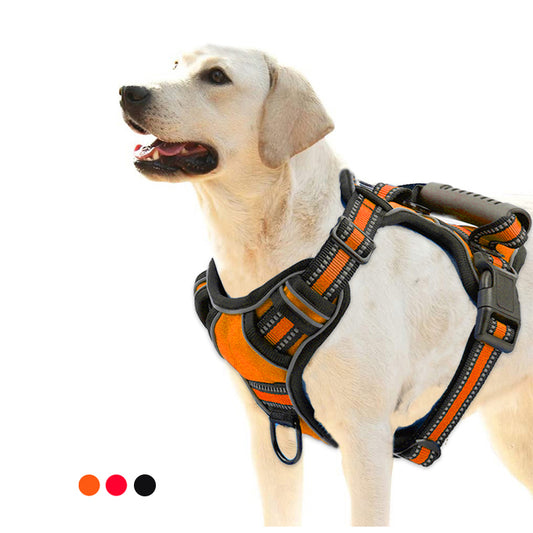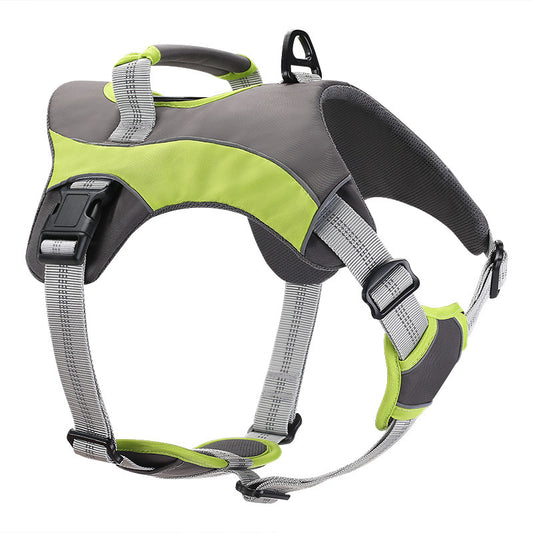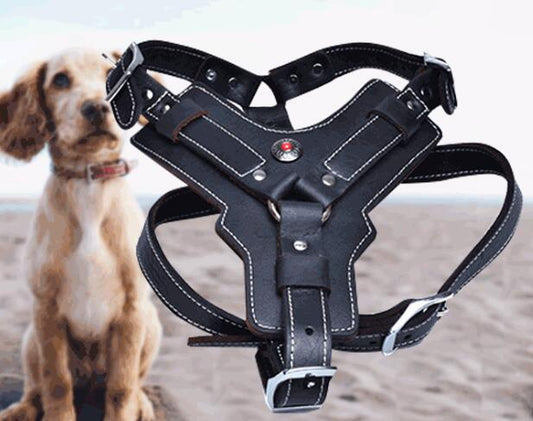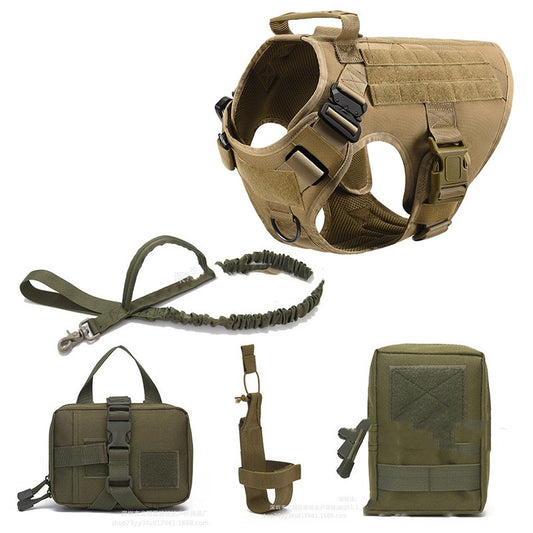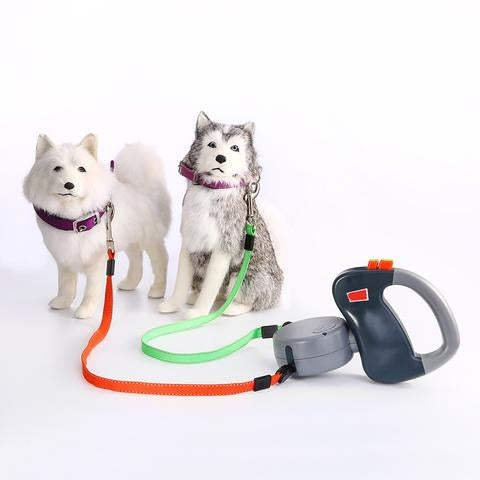The Ultimate Guide About Dog Harness With Handle
Dog harnesses with handle leashes have become increasingly popular in recent years as a safer and more comfortable option for dogs during walks and outdoor activities. These harnesses offer more control and stability than traditional collars and leashes, and they are available in a variety of styles, sizes, and features.
In this article, we will explore the benefits of using a dog harness with a handle leash and provide recommendations on the best harnesses for different types of dogs.
Why Use a Dog Harness with Handle Leash?
Dog harnesses with handle leashes offer several benefits over traditional collars and leashes, including:
- More control and stability during walks and outdoor activities.
- Improved safety for dogs with respiratory or neck issues.
- Reduced risk of choking, gagging, or injury to the neck and trachea.
- Greater comfort and less strain on the body.
- Better training and behaviour correction for dogs that pull or are difficult to control.
Types of Dog Harnesses
There are several types of dog harnesses available on the market, including:
-
Back Clip Harness: This type of harness has a leash attachment point on the back and is suitable for most dogs.
-
Front Clip Harness: This type of harness has a leash attachment point on the front and is suitable for dogs that pull or need extra control.
-
Dual Clip Harness: This type of harness has leash attachment points on both the front and back and is suitable for training and behavior correction.
-
Step-In Harness: This type of harness requires the dog to step into it and is suitable for dogs that are difficult to control.
-
Vest Harness: This type of harness covers the chest and is suitable for dogs with respiratory or neck issues.
Best Harnesses for Small Dogs
Small dogs require harnesses that are lightweight and easy to handle. Here are some subheadings and bullet points to consider:
-
PoyPet No Pull Dog Harness: This harness has a front clip leash attachment and is suitable for dogs up to 33 pounds.
-
Soft Mesh Dog Harness: This harness is made of breathable mesh and is suitable for dogs up to 12 pounds.
-
Ruffwear Web Master Harness: This harness has a padded chest and belly panel and is suitable for dogs up to 33 pounds.
Best Harnesses for Large Dogs
Large dogs require harnesses that are sturdy and durable. Here are some subheadings and bullet points to consider:
-
Kurgo Tru-Fit Smart Harness: This harness has a padded chest plate and is suitable for dogs up to 110 pounds.
-
Julius-K9 IDC Powerharness: This harness has a reflective strip and is suitable for dogs up to 176 pounds.
-
PetSafe EasySport Dog Harness: This harness has a padded handle and is suitable for dogs up to 132 pounds.
Best Front Clip Harnesses
Front clip harnesses offer extra control and are suitable for dogs that pull or need behavior correction. Here are some subheadings and bullet points to consider:
-
Blue-9 Balance Harness: This harness has an adjustable front clip and is suitable for dogs of all sizes.
-
PetSafe Easy Walk Harness: This harness has a front leash attachment and is suitable for dogs up to 130 pounds.
-
Chai's Choice Best Outdoor Adventure Dog Harness: This harness has a padded chest and is suitable for dogs up to 100 pounds.
Best Chest Plate Harnesses
Chest plate harnesses offer extra support and are suitable for dogs with respiratory or neck issues. Here are some subheadings and bullet points to consider:
-
Rabbitgoo Dog Harness: This harness has a breathable mesh and is suitable for dogs up to 75 pounds.
-
Embark Adventure Dog Harness: This harness has a padded chest plate and is suitable for dogs up to 250 pounds.
-
PetSafe EasySport Dog Harness: This harness has a padded chest and is suitable for dogs up to 132 pounds.
Best Harnesses for Active Dogs
Active dogs require harnesses that are durable and comfortable for outdoor activities. Here are some subheadings and bullet points to consider:
-
Ruffwear Front Range Harness: This harness has a padded chest and is suitable for dogs up to 250 pounds.
-
Hurtta Active Harness: This harness has a padded chest and is suitable for dogs up to 130 pounds.
-
EzyDog Convert Trail-Ready Harness: This harness has a padded chest plate and is suitable for dogs up to 130 pounds.
Special Features of Dog Harnesses
Dog harnesses come with various special features to enhance comfort and functionality. Here are some subheadings and bullet points to consider:
-
Adjustable Straps: Harnesses with adjustable straps allow for a secure fit and full range of motion.
-
ID Tags: Some harnesses come with ID tags or built-in identification to ensure your pet's safety.
-
Reflective Stitching: Harnesses with reflective stitching increase visibility during walks in low-light conditions.
-
Easy Walk: Some harnesses are designed to prevent pulling and promote good walking behavior.
-
Leash Attachment Point: Different harnesses have leash attachment points on the back, front, or both for extra control and training.
How to Choose the Right Size Harness
Choosing the right size harness is crucial for your pet's comfort and safety. Here are some tips to consider:
- Measure your dog's chest girth and neck girth to ensure a proper fit.
- Check the manufacturer's sizing chart and weight recommendations.
- Consider the type of harness and the amount of adjustability.
How to Adjust a Dog Harness
Adjusting a dog harness properly ensures a secure and comfortable fit. Here are some steps to follow:
- Place the harness on your dog and adjust the straps for a snug but not tight fit.
- Ensure the chest plate sits comfortably on your dog's chest and not on their throat.
- Check that the harness does not slide around or twist.
- Attach a leash and check that the harness allows for a full range of motion.
Proper Use of a Dog Harness with Handle Leash
To ensure your dog's safety and comfort, it's important to use a harness with handle leash properly. Here are some tips:
- Adjust the harness for a snug but not tight fit.
- Place the handle in a comfortable position for your grip.
- Use the handle to guide your dog and provide extra support.
- Don't pull or lift your dog by the handle.
- Use a leash attached to the harness to provide additional control and stability.
Benefits of a Handle Leash
Handle leashes provide additional control and support during walks and outdoor activities. Here are some benefits:
- Improved control over your dog's movements.
- Ability to guide your dog over obstacles or rough terrain.
- Extra support for dogs with mobility issues or disabilities.
- Easier to control a dog during training and behavior correction.
- Provides a sense of security and peace of mind.
Common Issues with Dog Harnesses
While dog harnesses with handle leashes offer many benefits, there are some common issues to be aware of. Here are some subheadings and bullet points to consider:
-
Poor Fit: An improperly fitted harness can cause discomfort, chafing, or rubbing.
-
Slipping: A poorly adjusted harness can slip or twist during walks, reducing control.
-
Chewing: Some dogs may chew on the harness, causing damage or destruction.
-
Limited Visibility: Some harnesses may cover or obstruct ID tags or visibility.
-
Limited Mobility: Some harnesses may restrict a dog's movement or range of motion.
How to Train Your Dog to Use a Harness
Training your dog to use a harness with handle leash properly is essential for their safety and comfort. Here are some steps to follow:
- Introduce the harness to your dog gradually, allowing them to sniff and inspect it.
- Offer treats or rewards for positive association with the harness.
- Practice putting on and taking off the harness.
- Attach a leash and practice walking and guiding your dog.
- Use positive reinforcement and consistency to encourage good behaviour.
Proper Maintenance of a Dog Harness with Handle Leash
To ensure the longevity and effectiveness of a harness with handle leash, proper maintenance is essential. Here are some subheadings and bullet points to consider:
-
Regular Cleaning: Clean the harness as needed, depending on the level of activity and dirt. Use mild soap and water and allow the harness to air dry.
-
Inspection: Regularly inspect the harness for signs of wear and tear, including fraying, loose stitching, or damage to the handle or leash attachment points.
-
Replacement: Replace the harness if it becomes damaged or if it no longer fits properly.
-
Storage: Store the harness in a dry, cool place, away from direct sunlight or moisture.
-
Consider Weather: Choose a harness with handle leash that is suitable for your climate and weather conditions.
Harness with Handle Leash for Senior Dogs
Senior dogs may require additional support and control during walks and outdoor activities. Here are some subheadings and bullet points to consider:
-
Padded Support: Choose a harness with handle leash that has a padded chest plate and extra support for senior dogs with mobility issues or arthritis.
-
Lightweight Material: Choose a lightweight harness that doesn't add additional strain to your senior dog's joints.
-
Dual Handles: Harnesses with dual handles allow for extra support and guidance during walks and can be especially helpful for senior dogs.
-
Comfortable Fit: Choose a harness with handle leash that fits comfortably and securely without causing discomfort or rubbing.
Harness with Handle Leash for Dogs with Disabilities
Dogs with disabilities require additional support and control during walks and outdoor activities. Here are some subheadings and bullet points to consider:
-
Supportive Material: Choose a harness with handle leash that provides extra support for dogs with mobility issues or disabilities.
-
Adjustable Straps: Harnesses with adjustable straps allow for a secure fit and can accommodate a range of disabilities and mobility levels.
-
Dual Handles: Harnesses with dual handles allow for extra support and guidance during walks and can be especially helpful for dogs with disabilities.
-
Customizable: Consider a harness with handle leash that can be customized to fit your dog's specific needs and disabilities.
Harness with Handle Leash for Training
Harnesses with handle leashes can be an effective tool for training and behavior correction. Here are some subheadings and bullet points to consider:
-
Positive Reinforcement: Use positive reinforcement techniques to encourage good behavior and obedience.
-
Consistency: Use the harness with handle leash consistently during training to reinforce positive behaviors and discourage negative behaviors.
-
Proper Fit: Ensure the harness fits properly and securely for effective training.
-
Leash Attachment Point: Choose a harness with handle leash that has a leash attachment point on the front or back, depending on your training goals.
Comparison of Harness with Handle Leash to Other Walking Tools
While a harness with handle leash can be a great option for dog walking, it's important to consider other tools as well. Here are some subheadings and bullet points to consider:
-
Collar: A collar provides less control than a harness with handle leash but can be suitable for dogs with good leash manners and no mobility issues.
-
Head Collar: A head collar provides more control than a collar but can be uncomfortable for some dogs.
-
Slip Lead: A slip lead provides control but can cause discomfort or injury if not used properly.
-
Traditional Leash: A traditional leash provides control but may not provide extra support or guidance.
How to Choose the Right Harness with Handle Leash for Your Dog
Choosing the right harness with handle leash for your dog can be overwhelming. Here are some subheadings and bullet points to consider:
-
Size: Choose a harness that fits your dog's size and weight.
-
Activity Level: Consider your dog's activity level and choose a harness that can accommodate their level of exercise.
-
Mobility Issues: Choose a harness with extra support and padding for dogs with mobility issues or arthritis.
-
Training: Choose a harness with handle leash that suits your training goals and techniques.
-
Comfort: Choose a harness that fits comfortably and securely without causing discomfort or rubbing.
Common Misconceptions About Harnesses with Handle Leashes
There are some common misconceptions about harnesses with handle leashes that are important to address. Here are some subheadings and bullet points to consider:
-
Restrictive: Some people believe that harnesses with handle leashes restrict a dog's movement, but a properly fitted harness should allow for full range of motion.
-
Only for Large Dogs: Harnesses with handle leashes are suitable for dogs of all sizes and can provide extra support and control for small and large dogs alike.
-
Only for Mobility Issues: While harnesses with handle leashes can be helpful for dogs with mobility issues, they can also be useful for training and behavior correction.
Frequently Asked Questions
Can I leave a harness on my dog all the time?
Answer: It's recommended to remove the harness when your dog is not supervised to prevent chewing or accidents. However, some harnesses are designed to be comfortable enough for extended wear.
How often should I wash a dog harness?
Answer: It's recommended to wash a dog harness as needed, depending on the level of activity and dirt. Use mild soap and water and allow the harness to air dry.
Can a dog slip out of a harness?
Answer: It's important to choose a harness that fits securely and has multiple points of attachment. Some dogs may be able to slip out of a poorly fitting harness, so regular checks and adjustments are recommended.
How do I choose the right type of harness for my dog?
Answer: Consider your dog's size, weight, activity level, and any special needs or issues. Consult with your veterinarian or a professional trainer for recommendations.
Can I attach a leash to a dog's collar and harness at the same time?
Answer: It's not recommended to attach a leash to both a collar and harness at the same time as it can cause discomfort and restrict movement. Choose one or the other depending on the situation and level of control needed.
Conclusion
Dog harnesses with handle leashes offer a safer and more comfortable option for dogs during walks and outdoor activities. With the variety of styles and features available, you can find the perfect harness for your furry friend based on their size, activity level, and special needs. When choosing a harness, consider factors such as adjustability, comfort, and leash attachment points.
Always make sure to properly adjust the harness and choose the appropriate size for your pet to ensure their safety and comfort. With a high-quality dog harness, you can enjoy your walks with your furry friend while providing them with the support and control they need.

